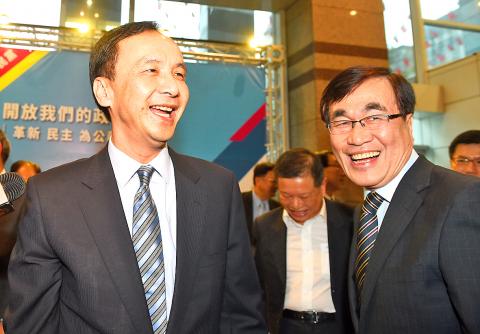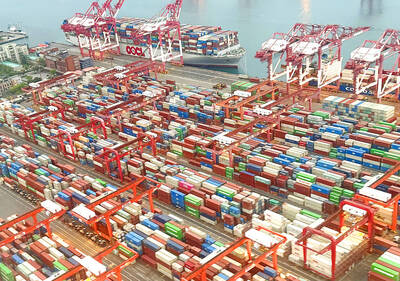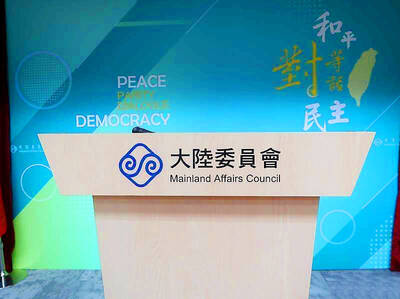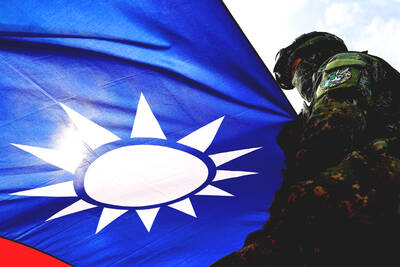Chinese Nationalist Party (KMT) Chairman Eric Chu’s (朱立倫) description of cross-strait relations as two sides “belonging to one China” risked leading to a “misunderstanding” that Taiwan belongs to the People’s Republic of China (PRC), Mainland Affairs Council Minister Andrew Hsia (夏立言) said in Taipei yesterday.
There is a subtle difference between that description and the so-called “1992 consensus” adopted by the government, under which both sides of the Taiwan Strait recognize that there is ‘“one China,” with each side having its own interpretation of what “China” means, Hsia told a meeting of the legislature’s Internal Administration Committee in Taipei.
The government has tried to avoid using the language Chu used because of political sensitivities and has opposed the formula whenever the Chinese mention it, Hsia said.

Photo: Chien Jung-fong, Taipei Times
“We consider it unacceptable. That position remains unchanged,” he said. “We would not choose to use of words he [Chu] did.”
However, Hsia commended Chu’s characterization of the “1992 consensus,” saying that Chu intended to highlight the importance of the consensus — although he used a different way to express it.
“If the ‘one China’ he [Chu] meant was the Republic of China [ROC], as he said it was, of course I am not opposed to the idea,” Hsia said.
Hsia was invited to the meeting to take legislators’ questions over Chu’s just-concluded trip to China, where he met Chinese President Xi Jinping (習近平) and attended the 10th Cross-Strait Economic, Trade and Culture Forum cohosted by the KMT and the Chinese Communist Party (CCP).
Chu’s statement that “both sides [of the Taiwan Strait] belong to ‘one China,’ with differences in connotations and definitions [of ‘one China’]” was at the center of the sometimes heated debate.
Hsia did not voice his opinion about Chu’s definition of the “1992 consensus” until he was grilled by legislators from the Democratic Progressive Party (DPP), the Taiwan Solidarity Union and the People First Party — one after another — about whether the government had shifted its position from the “1992 consensus,” or what it said was “one China, with each side having its own interpretation of what ‘China’ means” to “both sides belonging to ‘one China.’”
In the beginning, Hsia said the phrasing of “both sides belonging to ‘one China,’” was similar to the “1992 consensus” of “one China, with each side having its own interpretation of what ‘China’ means.”
Hsia said Chu was the first person in the ROC to describe cross-strait relations as being “two sides belonging to one China,” a term coined by Beijing and commonly used by Chinese officials — most recently by Xi in March.
He was then corrected by DPP Legislator Lee Chun-yi (李俊俋), who said former KMT chairmen Wu Poh-hsiung (吳伯雄) and Lien Chan (連戰) had both proposed the idea before.
The statement made by former Mainland Affairs Council minister Wang Yu-chi (王郁琦) in March 2013, in response to then-Chinese vice premier Li Keqiang (李克強), who said both sides belong to “one China,” that the characterization was “unacceptable” remains valid, Hsia said.

MORE VISITORS: The Tourism Administration said that it is seeing positive prospects in its efforts to expand the tourism market in North America and Europe Taiwan has been ranked as the cheapest place in the world to travel to this year, based on a list recommended by NerdWallet. The San Francisco-based personal finance company said that Taiwan topped the list of 16 nations it chose for budget travelers because US tourists do not need visas and travelers can easily have a good meal for less than US$10. A bus ride in Taipei costs just under US$0.50, while subway rides start at US$0.60, the firm said, adding that public transportation in Taiwan is easy to navigate. The firm also called Taiwan a “food lover’s paradise,” citing inexpensive breakfast stalls

TRADE: A mandatory declaration of origin for manufactured goods bound for the US is to take effect on May 7 to block China from exploiting Taiwan’s trade channels All products manufactured in Taiwan and exported to the US must include a signed declaration of origin starting on May 7, the Bureau of Foreign Trade announced yesterday. US President Donald Trump on April 2 imposed a 32 percent tariff on imports from Taiwan, but one week later announced a 90-day pause on its implementation. However, a universal 10 percent tariff was immediately applied to most imports from around the world. On April 12, the Trump administration further exempted computers, smartphones and semiconductors from the new tariffs. In response, President William Lai’s (賴清德) administration has introduced a series of countermeasures to support affected

CROSS-STRAIT: The vast majority of Taiwanese support maintaining the ‘status quo,’ while concern is rising about Beijing’s influence operations More than eight out of 10 Taiwanese reject Beijing’s “one country, two systems” framework for cross-strait relations, according to a survey released by the Mainland Affairs Council (MAC) on Thursday. The MAC’s latest quarterly survey found that 84.4 percent of respondents opposed Beijing’s “one country, two systems” formula for handling cross-strait relations — a figure consistent with past polling. Over the past three years, opposition to the framework has remained high, ranging from a low of 83.6 percent in April 2023 to a peak of 89.6 percent in April last year. In the most recent poll, 82.5 percent also rejected China’s

PLUGGING HOLES: The amendments would bring the legislation in line with systems found in other countries such as Japan and the US, Legislator Chen Kuan-ting said Democratic Progressive Party (DPP) Legislator Chen Kuan-ting (陳冠廷) has proposed amending national security legislation amid a spate of espionage cases. Potential gaps in security vetting procedures for personnel with access to sensitive information prompted him to propose the amendments, which would introduce changes to Article 14 of the Classified National Security Information Protection Act (國家機密保護法), Chen said yesterday. The proposal, which aims to enhance interagency vetting procedures and reduce the risk of classified information leaks, would establish a comprehensive security clearance system in Taiwan, he said. The amendment would require character and loyalty checks for civil servants and intelligence personnel prior to